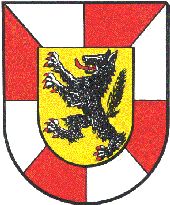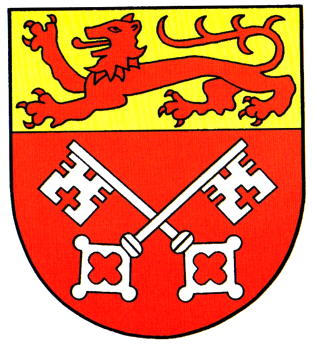Stuhr: Difference between revisions
Knorrepoes (talk | contribs) No edit summary |
Knorrepoes (talk | contribs) m (Text replace - "[[Literature" to "{{media}} [[Literature") |
||
| Line 26: | Line 26: | ||
The two crossed keys are the symbol of the Archdiocese of Bremen, as the Archbishops had a large influence in the area for many centuries. The lion is taken as a symbol for the Saxon King Heinrich der Löwen (Henry the lion), who granted market rights to the village in the 13<sup>th</sup> century. The red and gold of the chief are the colours of the State of Oldenburg, to which the area later belonged. | The two crossed keys are the symbol of the Archdiocese of Bremen, as the Archbishops had a large influence in the area for many centuries. The lion is taken as a symbol for the Saxon King Heinrich der Löwen (Henry the lion), who granted market rights to the village in the 13<sup>th</sup> century. The red and gold of the chief are the colours of the State of Oldenburg, to which the area later belonged. | ||
{{media}} | |||
[[Literature]] : Furchert, 2003 | [[Literature]] : Furchert, 2003 | ||
Revision as of 06:24, 9 July 2014
| Heraldry of the World Civic heraldry of Germany - Deutsche Wappen (Gemeindewappen/Kreiswappen) |
STUHR
State : Niedersachsen
District (Kreis) : Diepholz
Additions : 1974 Brinkum, Fahrenhorst, Groß Mackenstedt, Heiligenrode, Seckenhausen
Official blazon
Achtfach von Rot und Silber geständert, belegt mit rotbewehrtem schwarzem Wolf im goldenen Herzschild.
Origin/meaning
The arms were granted on ?
The shield is divided in 8 parts, symbolising the 8 villages in the municipality. I have no information on the meaning of the wolf. The arms replaced the previous arms below.
The previous arms were granted on January 13, 1950.
The two crossed keys are the symbol of the Archdiocese of Bremen, as the Archbishops had a large influence in the area for many centuries. The lion is taken as a symbol for the Saxon King Heinrich der Löwen (Henry the lion), who granted market rights to the village in the 13th century. The red and gold of the chief are the colours of the State of Oldenburg, to which the area later belonged.
Contact and Support
Partners:
Your logo here ?
Contact us
© since 1995, Heraldry of the World, Ralf Hartemink 
Index of the site
Literature : Furchert, 2003












